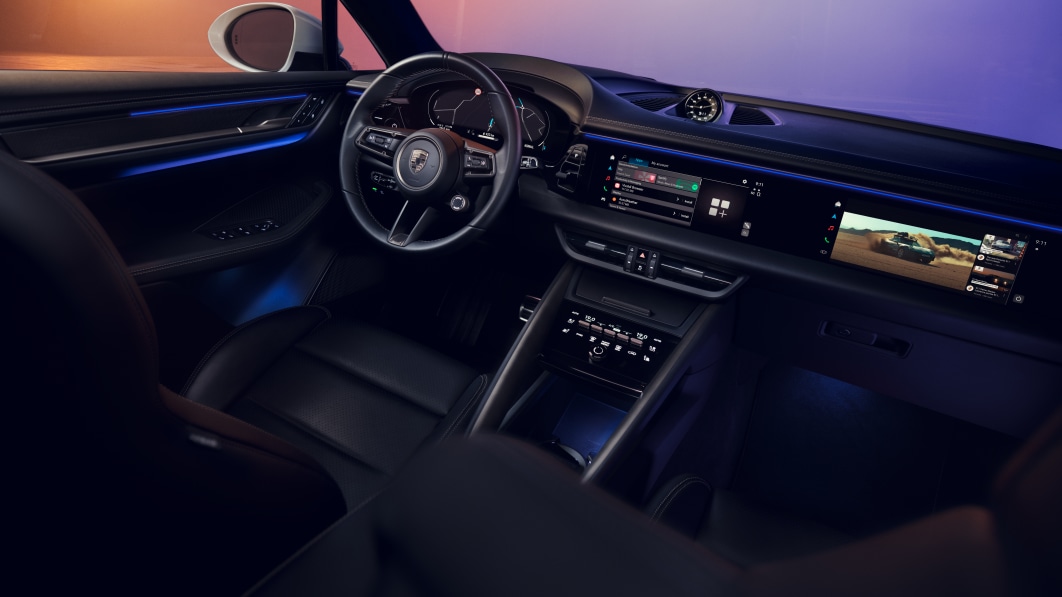Porsche Macan EV’s interior shown off, and we go for a high-speed ride

LEIPZIG, Germany — Fully electric, and electric only, the next-generation Porsche Macan will make its debut in 2024. Details about the model are trickling out: the Stuttgart-based brand unveiled the EV’s interior, provided additional powertrain details, and gave Autoblog a high-speed ride in a prototype.
Inside, the Macan EV looks familiar if you’ve seen other recent additions to the Porsche range, like the new versions of the Panamera and the Cayenne. The driver faces a 12.6-inch digital instrument cluster that can be configured to display a wide selection of information. There’s a round start button on the left side of the instrument cluster and the increasingly familiar razor-shaped shifter located on the right side of it.
The middle part of the dashboard houses a 10.9-inch touchscreen that displays a new, Android-powered infotainment system. The software boots up as soon as it detects that the driver is approaching the car with the key, so it’s ready to go by the time you’re buckled up, and it’s compatible with third-party applications such as Spotify, Amazon Music, and YouTube. Users can download apps like on a smartphone. This function will come in handy while charging, and the front passenger can stream videos on-the-move via an optional 10.9-inch touchscreen integrated into the right side of the dashboard. I tried this feature in the Cayenne and couldn’t tell the screen was on from the driver’s seat.
Android Auto and Apple CarPlay compatibility come standard, though Miriam Mohamad, the manager of infotainment and connectivity for the Macan line, tells me over 85% of Porsche owners are Apple users. Smartphone integration goes beyond merely overlaying the touchscreen with a new interface: when using Google Maps or Apple Maps, the driver can send the third-party map to the Macan’s instrument cluster.
When it goes on sale in a few months, the Macan EV will stand out as the first Porsche model offered with an augmented-reality head-up display. The system uses interactive color-coded symbols, such as arrows, to provide navigation directions and other information. Porsche notes its new head-up display projects data approximately 33 feet ahead of the driver on what corresponds to a gigantic 87-inch display.
As we’ve previously reported, the Macan EV will ride on the modular Premium Platform Electric (PPE) architecture developed jointly by Audi and Porsche. It will ship with a dual-motor all-wheel-drive powertrain configured to deliver rear-biased handling, and engineers dialed in a 48-percent front and 52-percent rear weight distribution. It shouldn’t feel like a 911, but it likely won’t feel like a front-heavy SUV, either.
Porsche hasn’t released technical specifications yet. All we know at this stage is that the top variant offered at launch will put about 603 horsepower and more than 737 pound-feet of torque under the driver’s right foot. While these figures will make it far more powerful than any version of the current-generation Macan, which tops out at 434 horsepower in GTS trim, keep in mind that going electric adds a tremendous amount of weight. Driving range remains up in the air as well, though the 800-volt electrical architecture unlocks up to 270-kilowatt charging.
From the passenger’s seat of a pre-production prototype, the Macan EV feels like a sports car. We’re on the test track next to the Porsche factory in Leipzig, Germany, and one of the brand’s development drivers is at the wheel. He floors it to exit the pit lane and the acceleration punches me in the gut as it pins me to the seat. It doesn’t stop, either: there are no gears for the driver to go through, so the Macan builds up speed without pausing for a shift until the driver hits the brakes. Once we’re on the track, which includes famous sections of other race tracks such as Laguna Seca’s Corkscrew, the only indications that you’re sitting in an SUV are the relatively spacious interior and the high seating position. Otherwise, you may as well be in a low-slung coupe. It turns (and even four-wheel drifts!) with what feels like surgical precision.
It helps that the 100-kilowatt-hour lithium-ion battery, which is the heaviest part of the car, lives below the passenger compartment, where it lowers the center of gravity. Using the PPE platform also allowed Porsche to add more technology to the list of standard and optional features. There’s an available rear-wheel steering system (a first for the Macan) and, on some trims, a height-adjustable air suspension system. Jörg Kerner, the vice president of the Macan line, tells me the development team’s goal is to make the EV the sportiest model in its segment. He adds that the performance (including what feels like a three-ish-second sprint from zero to 60 mph) will be repeatable.
The brakes bring the Macan to a stop with no fuss, even from triple-digit speeds on a straight part of the track, but without spending time behind the wheel I can’t tell you whether the pedal feels artificial like in many electric and plug-in hybrid models or natural like you’d expect to find in a Porsche. Kerner explains the electric motors can recuperate at up to 240 kilowatts, which represents around 14.1 feet per second.
Built in Leipzig, Germany, the Macan EV will make its debut at some point in 2024. It will likely go on sale as a 2025 model. You’re not out of luck quite yet if you’re not interested in going electric: the current-generation Macan will be sold alongside its successor for some time.
